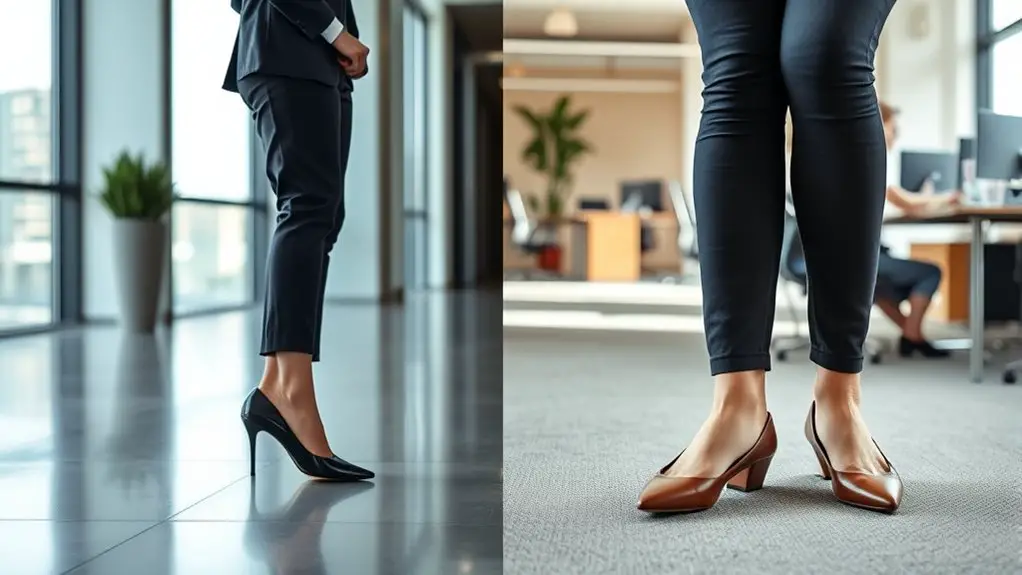Requiring heels in certain jobs can enhance your professional image, signaling authority and ambition. However, the health risks associated with high heels can’t be ignored, like chronic pain and foot issues. Comfort plays a crucial role in your productivity and satisfaction at work. Embracing inclusive dress codes can reflect modern values and allow for personal expression. You might be surprised at the stylish alternatives available that can keep you looking sharp without sacrificing comfort.
The Case for Heels: Enhancing Professionalism and Image

While some might argue that comfort should come before style in the workplace, there’s no denying that wearing heels can elevate your professional image. In a corporate culture that often emphasizes first impressions, the right pair of heels can enhance your style perception, making you appear more confident and polished. When you step into a meeting room, those heels can subtly signal authority and ambition, setting the tone for how others perceive you. It’s not just about aesthetics; it’s about aligning with the expectations of your industry. Heels have a way of transforming an outfit and reinforcing a professional identity, allowing you to embody the role you aspire to. So, if you want to make a powerful statement and navigate your career with style, consider the impact of those heels. They can be your secret weapon in a competitive environment, helping you stand out while also fitting seamlessly into the corporate landscape.
Health Risks Associated With Wearing High Heels
Despite the undeniable boost in confidence and professionalism that heels can provide, it’s important to contemplate the health risks they pose. Wearing high heels can seriously compromise your foot health. The unnatural angle they create puts excessive pressure on the balls of your feet, leading to painful conditions like bunions and plantar fasciitis. Over time, you might not just experience discomfort; long term effects can include misalignment of your spine and knees, which can affect your overall posture and mobility.
You may love the way heels elevate your outfit, but think about how they might be elevating your risk for chronic pain. The stylish allure of high heels often comes with a hefty price tag on your well-being. It’s essential to weigh the aesthetic benefits against the potential health costs, making informed choices that prioritize your foot health for the long run.
Impact on Employee Comfort and Productivity

When you slip on a pair of high heels for work, you may not realize the extent to which they can impact your comfort and productivity. While they might elevate your style, they can also lead to discomfort that distracts you from your tasks. Uncomfortable shoes can sap your energy and focus, ultimately affecting your performance. When employees feel good in what they wear, it boosts employee satisfaction and enhances overall workplace morale.
Imagine walking into a meeting, confident and at ease, instead of wincing with every step. Comfort directly correlates with productivity; when you’re not battling heel-related pain, you can channel your energy into creativity and collaboration. Companies that prioritize comfort in dress codes often notice a positive shift in employee engagement. So, reconsider the heels—your comfort just might be the key to releasing your best work.
Inclusivity and Gender Equality in Dress Codes
As you navigate the complexities of workplace attire, it’s essential to recognize how dress codes can either promote inclusivity or reinforce outdated gender norms. By addressing gender bias in dress codes, companies can create a more equitable environment for everyone. Think about the impact of your dress code policy:
- Encourages self-expression: Allows individuals to showcase their identity without conforming to restrictive norms.
- Promotes comfort and productivity: A diverse dress code can enhance focus and job satisfaction.
- Fosters equality: Eliminating gender-specific requirements levels the playing field.
- Reflects modern values: A progressive dress code aligns with contemporary ideas of inclusivity.
Revising dress codes to eliminate gender bias isn’t just a trend; it’s a necessity. When workplaces prioritize inclusivity, everyone benefits, leading to a more harmonious and productive atmosphere. Let’s advocate for change and make workplaces welcoming for all.
Alternatives to High Heels in Professional Settings

In a workplace that values inclusivity and equality, the expectation to wear high heels can feel outdated and unnecessary. You deserve to express your professional style without sacrificing comfort. Consider flats options that blend sophistication with ease, allowing you to move confidently throughout your day. Stylish loafers or pointed-toe ballet flats can elevate your outfit while keeping you grounded.
Another trendy alternative is professional sneakers, which have taken the corporate world by storm. These aren’t your average gym shoes; they’re designed to look polished while providing support for long hours. Pair them with tailored trousers or a chic dress, and you’ve got a winning combination that’s both practical and fashionable.
Frequently Asked Questions
Are There Specific Industries Where Heels Are More Commonly Required?
Did you know that 57% of women in corporate roles feel pressured to wear heels? In industries like fashion and corporate attire, heels often symbolize professionalism, reinforcing fashion standards that can influence perceptions and expectations.
How Do Different Cultures Perceive High Heels in the Workplace?
Different cultures shape perceptions of high heels in the workplace, often intertwining cultural norms and gender expectations. While some see heels as empowering, others view them as restrictive, reflecting varying attitudes towards professionalism and femininity.
What Legal Protections Exist Against Mandatory Heel Policies?
You should know that mandatory heel policies can lead to legal implications, potentially classifying them as workplace discrimination. Employees often have rights to comfortable footwear, and enforcing such policies might violate anti-discrimination laws protecting personal choices.
Can Wearing Heels Influence Hiring Decisions?
Oh sure, because nothing screams competence like a pair of heels! Heel perceptions can definitely skew hiring biases, making you wonder if employers value style over substance. It’s a bizarre world we’re maneuvering through, isn’t it?
How Do Men in the Workforce View High Heel Requirements?
From a male perspective, high heel requirements can seem outdated, undermining workplace equality. Many men believe such expectations reinforce gender stereotypes, hindering progress. It’s essential to foster an environment where everyone feels valued and comfortable.



